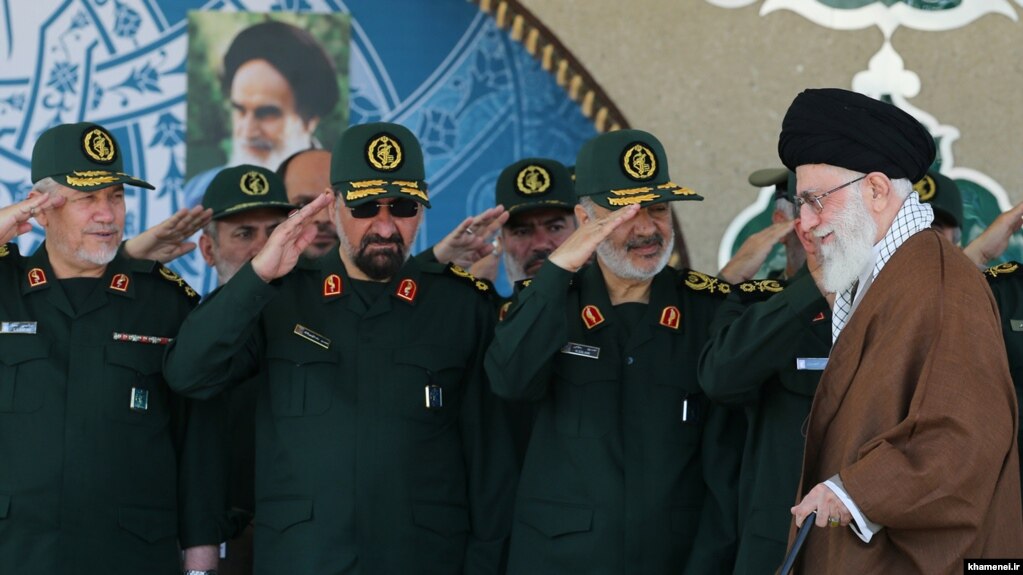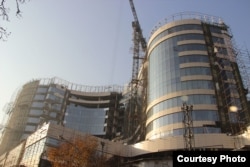Radiofarda – On May 5, 1979, Iran’s new government founded the Islamic Revolutionary Guard Corps (IRGC). Almost from the beginning, the IRGC had a built-in malleability—one enshrined in Iran’s constitution. Pursuant to Article 150, the IRGC is “to be maintained so that it may continue in its role of guarding the revolution and its achievements. The scope of the duties of this corps… [is] to be determined by law with emphasis on brotherly cooperation and harmony.” Thus the IRGC was birthed with vagueness and versatility. Forty years later, this structural adaptability has resulted in a mixed record for the organization:

The IRGC is aging but still agile
The top brass of the IRGC is graying. They are all of the same military generation. Its three longest-serving commanders-in-chief—Mohsen Rezaee, Yahya Rahim Safavi, and Mohammad Ali Jafari—were all born in the 1950s. Its new leader, Hossein Salami, was born in 1960. They are all veterans of the Iran-Iraq War—a crucible which birthed the IRGC’s strategy, strength, and stratum within Tehran’s power hierarchy. And many have held almost decades-long tenures in their current roles—the commander of the Quds Force Qassem Soleimani has been in place since 1998; the head of the Aerospace Force, Amir Ali-Hajizadeh, has held his post since 2009; and ditto for both Mohammad Pakpour, who manages the Ground Force, and Hossein Taeb, the director of the IRGC’s fearsome Intelligence Organization.SEE ALSO:
Who is Who IRGC Edition
But nevertheless, the IRGC has managed to adapt itself to the changing environment in the Middle East, leading Iran’s efforts to counter Washington’s pressures. The Guards’ crown jewel – the Quds Force, led by Qassem Soleimani – has evolved from a secret and lucrative elite force in the 1980’s and 1990’s, into an Iranian “command” and headquarters for Iranian and Shia forces operating throughout the region. Responsible for dozens of terror attacks in the region and beyond, Soleimani’s organization has overshadowed its parent organization. Other less “prestigious” organs in the IRGC network have grown to become masters evading sanctions, financing Iran’s nuclear program, and projecting Iran’s military might.
The IRGC is career-making but also career-ending
It is an Ivy League brand in the Islamic Republic, and has launched the careers of politicians, senior policymakers, and businessmen. Mohsen Rezaee, the longest serving chief of the IRGC (1981-1997), leveraged his wartime experience to run for parliament and presidency. Mohammad Bagher Qalibaf, who headed the IRGC’s air force, went on to become mayor of Tehran and another presidential contender. Mahmoud Ahmadinejad himself, who joined the IRGC in 1986, servedtwo terms as president. Additionally, according to one study, the amount of ex-IRGC legislators in Iran’s parliament “doubled” from 2000-2008.SEE ALSO:
Anatomy Of Suppression In Iran: The Institutions & Tactics That Repeatedly Quash Dissent
The Guards have also filled the Islamic Republic’s cabinets, past and present: Ali Shamkhani, Hossein Dehghan, Ahmad Vahidi, and Rostam Ghasemi all managed divisions of the IRGC, before their appointments as ministers of defense and oil, respectively. Many senior commanders of the IRGC have also monetized their experience. Mohsen Rafighdoost, the first minister of the IRGC in the nascent years of the Islamic Republic, when it held its own cabinet ministry, was later appointed as head of the Bonyad Mostazafan, one of the largest charitable foundations in Iran, eventually making him as one of Iran’s wealthiest men.
At the same time, service in the IRGC has not proved to be decisive electorally. Rezaee’s career stagnated after running for the presidency three times since 2005 – only to eventually stay in his current post of secretary of the Expediency Council for over 20 years. Likewise for Qalibaf, whose meteoric rise from the head of the IRGC’s air force, to the head of Iran’s national police, and finally to mayor of Tehran for over a decade has been thwarted by multiple unsuccessful presidential campaigns. In fact, to date, only one of Iran’s presidents has served within the IRGC’s rank and file—Mahmoud Ahmadinejad—as has only one of Iran’s speakers of parliament, Ali Larijani. In the end, the IRGC pedigree has advanced the lives of Iran’s appointed power players, but hasn’t had the same effect on the polls at the presidential level.
The IRGC is an economic balm but also a bugbear

The IRGC has been one of Iran’s main economic engines for decades, controlling important sectors such as construction, infrastructure, and energy. Notably, Khatam al-Anbiya, one of the Guards’ major affiliates, is employing tens of thousands of Iranians in huge projects worth billions of dollars. The company’s former commander General Abdollahi remarked in 2018 that his organization would complete 40 “mega projects” in various fields by March 2019. The IRGC is also an important tool by the regime to implement its “Resistance Economy” doctrine – aimed at increasing self-reliance of the Iranian economy and decreasing its vulnerability to external pressures. Only recently did Khatam al-Anbiya enter oil-related projects in order to fill the void caused by the withdrawal of foreign companies.SEE ALSO:
Khamenei Diverts Next Generations’ Savings To Fund His Military Ambitions
Yet the Guards’ influence on the economy has also been a major problem for Iran. Its close relationships with many companies expose them to international sanctions, especially after the IRGC was designated by the U.S. government as a Foreign Terrorist Organization. In addition the IRGC is perceived to be a main impediment to implementing anti-money laundering and terrorist financing norms in the country. By hindering the chances of any successful reform in this field, the IRGC has so far prevented Iran from joining the Financial Action Task Force, thus deterring international companies from doing business with Tehran. The IRGC’s hold on the economy has also caused continuous rifts between the IRGC and President Rouhani, who has repeatedly called on the IRGC to distance itself from Iran’s budgeting and economics, and solely retain its position as a military organization.
Looking in retrospect, the IRGC has fulfilled its number one goal – guarding the Islamic Republic for over four decades, and exporting its revolution to Lebanon, Iraq, Syria, Yemen, and beyond. Yet the challenges that Iran is facing put a big question mark on the IRGC being able to celebrate another successful decade.
 Shabtabnews In this dark night, I have lost my way – Arise from a corner, oh you the star of guidance.
Shabtabnews In this dark night, I have lost my way – Arise from a corner, oh you the star of guidance.


